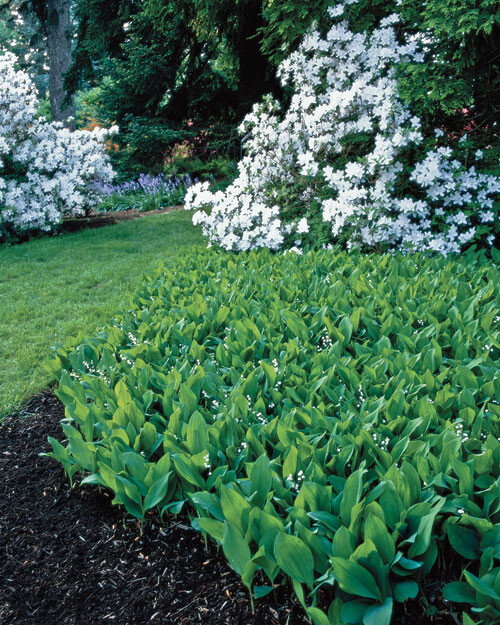
Have you ever known someone dainty, attractive, and exceedingly charming, yet surprisingly determined? Many gardeners would describe the diminutive lily of the valley as just such a character.
With its deeply fragrant flowers -- scallop-edge bells that dangle above bright emerald-green leaves -- this nearly deer-proof shade lover appears to be delicate in an old-fashioned way. But the pretty plant is also an intrepid wanderer, spreading readily and rapidly, and anyone who gardens in a small space will want to watch this perennial to make sure it stays in bounds.
Convallaria majalis gets its botanical name from the Latin words for "valley" (vallis) -- its natural habitat in Europe and parts of Asia, where it thrives in shady nooks -- and "May-blooming" (majalis). Many nurseries list lily of the valley as restricted to full shade, but the plant (hardy in Zones 3 to 8) will tolerate bright shade and even some sun.
As a ground cover under tall trees or large woody shrubs, lily of the valley is hard to match for its long blooming period during the growing season. The tidy leaves can grow six to 10 inches tall, depending on the variety, and produce arching flowers that last several weeks, followed in fall by orange-red berries.
Give your rooted plantlets (called "pips") good soil with even moisture and they will reward you by quickly covering a lot of ground, even in problematic areas around trees. The plants spread by aggressively extending their horizontal roots just under the soil's surface and sprouting leaf-bearing stems every few inches, hence their reputation for assertiveness.
The plant's heavenly scent, however, has proved much harder to replicate, at least for perfumers. To Calice Becker, executive perfumer for the Swiss fragrance company Givaudan, part of the scent's appeal lies in its elusiveness outside nature. "Lily of the valley is one of those flower essences that perfumery is not able to extract," she says.
The tiny flowers make the process too labor intensive and expensive. Fragrance companies instead produce sophisticated synthetic versions, usually labeled muguet, the plant's French name. Gardeners, however, can content themselves with the real thing when lily of the valley flowers each spring.
Ellen Hornig, a former nursery owner who grows five varieties in Oswego, New York, has been cultivating lilies of the valley for 20 years and continually adds to her collection, even if the plants are a bit unruly. "Let's face it; they aren't polite," she says.
Hornig suggests putting them next to vigorous woody shrubs and trees and keeping a close eye on them. The best way to control unbridled growth is to dig up any unwanted plants right after they finish blooming and give them to gardening friends -- with fair warning.
One of Hornig's favorites, 'Fernwood's Golden Slippers,' has chartreuse foliage, which retains its bright yellow-green color throughout summer. Another variety, 'Flore Pleno,' is an older type admired for its large double flowers held high up, providing easier viewing. No wonder gardeners can't resist letting the ambitious little species have the run of the place -- within reason, of course.
Seven Wonders
1 . Convallaria majalis 'Fernwood's Golden Slippers' emerges bright yellow-green and holds its color throughout summer.
2. 'Hardwick Hall' is a vigorous grower with chartreuse edges on the leaves.
3. The broad deep-green foliage of 'Albomarginata' is edged with a white line.
4. 'Albostriata' has white-streaked leaves and an open habit that shows off blooms.
5. 'Rosea' produces pink-tinged flowers.
6. 'Flore Pleno' is a robust grower with larger, double-bell flowers.
7. The straight species, or pure version, is among the taller varieties, growing up to 10 inches.
Tips and Sources
Good to Know
Having flower trouble? Over the years, a thick patch of lily of the valley may become congested with its own roots, which can compromise flowering. Rejuvenate your beds by taking out a third or so of the pips and adding some fresh soil and compost. The blossoms will return the following season.
Sources
·Forest Farm
·Klehm's Song Sparrow
·Odyssey Bulbs
·White Flower Farm